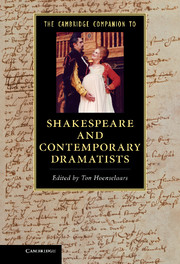Book contents
- Frontmatter
- Contents
- Illustrations
- Contributors
- Preface
- Chronology of the life and work of Shakespeare and contemporary dramatists
- 1 John Lyly and the University Wits
- 2 Thomas Kyd and the Elizabethan blockbuster
- 3 ‘The words of Mercury’
- 4 The dyer’s hand
- 5 Urbane John Marston
- 6 Thomas Dekker and the emergence of city comedy
- 7 Shakespeare
- 8 Thomas Heywood
- 9 George Chapman’s learned drama
- 10 Francis Beaumont and John Fletcher’s tragicomedy as musical melodrama
- 11 Thomas Middleton and the early modern theatre
- 12 John Webster
- 13 John Ford
- 14 Philip Massinger
- 15 Richard Brome and the idea of a Caroline theatre
- 16 Troublesome histories
- Select bibliography
- Index
- References
10 - Francis Beaumont and John Fletcher’s tragicomedy as musical melodrama
Published online by Cambridge University Press: 05 December 2012
- Frontmatter
- Contents
- Illustrations
- Contributors
- Preface
- Chronology of the life and work of Shakespeare and contemporary dramatists
- 1 John Lyly and the University Wits
- 2 Thomas Kyd and the Elizabethan blockbuster
- 3 ‘The words of Mercury’
- 4 The dyer’s hand
- 5 Urbane John Marston
- 6 Thomas Dekker and the emergence of city comedy
- 7 Shakespeare
- 8 Thomas Heywood
- 9 George Chapman’s learned drama
- 10 Francis Beaumont and John Fletcher’s tragicomedy as musical melodrama
- 11 Thomas Middleton and the early modern theatre
- 12 John Webster
- 13 John Ford
- 14 Philip Massinger
- 15 Richard Brome and the idea of a Caroline theatre
- 16 Troublesome histories
- Select bibliography
- Index
- References
Summary
Their Plays are now the most pleasant and frequent entertainments of the Stage; two of theirs being acted through the year for one of Shakespeare’s or Johnson’s.
(John Dryden)Shakespeare’s contemporaries Francis Beaumont (c. 1584–1616) and John Fletcher (1579–1625) dominated the English stage for much of the seventeenth century. Dryden’s affirmations notwithstanding, their popularity quickly faded thereafter, and Beaumont and Fletcher have been in near oblivion for centuries. Generations of critics would probably agree with T. S. Eliot’s harsh assessment: ‘The blossoms of Beaumont and Fletcher’s imagination draw no substance from the soil, but are cut and slightly withered flowers stuck into sand’. After individual experimental plays – Beaumont’s The Knight of the Burning Pestle (1607) and Fletcher’s The Faithful Shepherdess (1608–10) – the playwrights achieved spectacular collaborative success. They are best known for developing English tragicomedy, the new, hybrid genre that dominated the English stage for nearly a century and substantively influenced future English drama.
Even though the collaborators did not technically invent tragicomedy, which was an outgrowth of the English tradition (Marston’s earlier Malcontent [1603] was registered as a ‘tragicomedia’), they perfected and disseminated it. Sir Philip Sidney disparages mingling ‘Kings & Clownes’ and ‘Horne-pypes and Funeralls’ in ‘mungrell Tragy-comedie’ and Shakespeare’s Hamlet, joining the quarrel, asserts that in serious scenes clowns should ‘speak no more than is set down for them’ (3.2.32) – that is, not add lines with improvisation. In response to these opinions, in his address ‘To the Reader’ published with The Faithful Shepherdess in 1609 Fletcher writes, ‘A tragie-comedie is not so called in respect of mirth and killing, but in respect it wants deaths, which is inough to make it no tragedie, yet brings some neere it, which is inough to make it no comedie: which must be a representation of familiar people’.
- Type
- Chapter
- Information
- Publisher: Cambridge University PressPrint publication year: 2012

